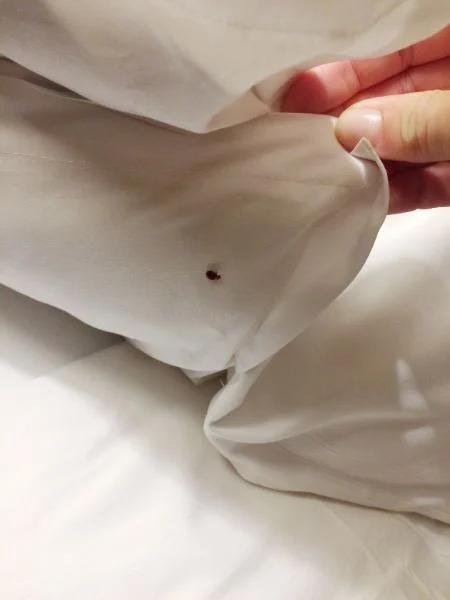What Does Bed Bug Infestation Look Like?
Home » Blog » What Does Bed Bug Infestation Look Like?
Las Vegas Bug Control
– Should you find brownish black or reddish stains on your mattress or bedding, it might mean that you have an infestation. Additionally, the material they’re feeding on could have hemorrhoid holes or rashes, which may be a symptom of bed bugs too. The reason that these would be the first places you should consider is because they’re generally at the simplest places to hide. The bed bug look clock will help wake you up, and also the damage brought on by an infestation might actually be worse than the bed bug itself.
Do Bed Bugs Come Out During The Day
– During the daytime, bed bugs are mostly nocturnal. If you see any red blood onto your bed or on neighboring sheets or mattresses, this is a certain indication of a bed bug infestation.
What Do Bed Bugs Look Like To The Human Eye
– Another symptom that will tell you exactly what does bed bug look like? Should you see eggs in your mattress, then there are opportunities that your infested area is afflicted by infestations of bed bugs. These may result in serious health problems later on. That’s the reason you should take immediate actions to stop this from happening to you and for your home.
You will start to itch and burnoff, and then the sting contributes to redness and subsequently swelling. You might also develop a fever, which may be a symptom of bed bugs. The bed bug looks like a bug but it is no match for its precision in hunting humans out. The moment you find where you live, you should take action immediately to get rid of this pest and stop it from coming back.
Bed Bug Eggs on Mattress
Whenever you’ve got a bed bug infestation, it usually means that there are over thirty thousand red blooded bugs under your bed right now! Following is a bed bug look timeline to offer you a better idea of what to search for.
What does bed bug look like? There are several distinct sorts of bed bugs, and they are available in various sizes. But most are microscopic and can only be seen by the naked eye. This is exactly what makes having an infestation of bed bugs this type of mystery.
– It isn’t just the bed bugs that are a symptom of an infestation. You will also find dead maggots in your sheets or garments, which are frequently signs of bed bugs. These may allow you to itch very badly, and if you are lucky you might not even understand that you have them before the disease has spread throughout your body. The bed bug looks dull, so you will observe that they frequently have a brownish tinge to their color.
– The bed bugs are extremely tiny. You will be able to see them because they’ll be dark brown or black in color. They will typically reach approximately 5 millimeters in length and there’s even some species that can grow up to six millimeters long. However, you can be ensured that even the smallest member of this pest may provide you a serious difficulty later on. This may impact your health badly and may also get worse if you do not do anything to stop it simultaneously.
How To Protect Yourself From Bed Bugs At Night
– In the day, bed bugs tend to be more active. You will find them feeding while you are asleep, and that’s when they’re most active. They may also be sitting on your bed or furniture.
– When you wake up in the morning, you may end up with what resembles a bee hive. This is a result of the simple fact that they are likely to be feeding in your blood now. A bed bug look clock helps wake you up, too. This is 1 symptom of a bed bug infestation that may surprise you.
Pictures Of Bed Bugs On Mattress

How can bed bug look like? If you want to know more about these bothersome insects and what exactly causes them to bite, see Green Wave Pest Solutions now. They can help you to find ways to protect against any intrusion of bed bugs in your house and in your region.

This 2006 photo depicted a dorsal view of a bed bug nymph, Cimex lectularius, as it was in the process of ingesting a blood meal from the arm using a”voluntary” human host, which might be seen filling the insect’s abdomen. Bed bugs aren’t vectors in nature of any known human disease. Even though some disease organisms have been recovered from bed bugs under laboratory conditions, none have been demonstrated to be transmitted by bed bugs outside of the laboratory. The common bed bug is located worldwide. Infestations are common in the developing world, occurring in configurations of unsanitary living conditions and acute hepatitis. In North America and Western Europe, bed bug infestations became uncommon during the next half of the 20th century and also have been regarded as a condition that occurs in travelers returning from developing countries. However, anecdotal reports suggest that bed bugs are increasingly common in the United States, Canada, and the uk. An immature bed bug may take several weeks to grow to an adult and an adult bed bug could live for up to a year. During evolution, the young bed bug will feed frequently on the blood of people, and may exist for several months between blood glucose. Bed bugs inject saliva into the blood stream of their host to thin the blood, and to avoid coagulation. It is this saliva that causes the intense itching and welts. In some cases, the itchy bites may develop into painful welts that survive several days. The common bed bug C. lectularius is a wingless, red-brown, blood-sucking insect that grows up to 7 mm in length and has a lifespan from 4 weeks to 1 year. Bed bugs hide in cracks and crevices in beds, wooden furniture, floors, and walls during the daytime and emerge at night to feed on their preferred host, people.
This 2006 photo depicted a dorsal view of a bed bug nymph, Cimex lectularius, as it was in the process of ingesting a blood meal from the arm using a”voluntary” human host, which might be seen filling the insect’s abdomen. Bed bugs aren’t vectors in nature of any known human disease. Even though some disease organisms have been recovered from bed bugs under laboratory conditions, none have been demonstrated to be transmitted by bed bugs outside of the laboratory. The common bed bug is located worldwide. Infestations are common in the developing world, but also frequently found in Enterprise, Rhodes Ranch, Southern Highlands, Spring Valley, Silverado Ranch, Seven Hills, Paradise, Las Vegas Strip Area, The Lakes, Summerlin near Mountains Edge, Nevada. Perhaps this is due to the millions of travelers that come to Nevada and potentially bring the bugs in their luggage and clothing. In North America, bed bug infestations became uncommon during the next half of the 20th century and also have been regarded as a condition that occurs in travelers returning from developing countries. However, anecdotal reports suggest that bed bugs are increasingly common in the United States, Canada, and the uk. An immature bed bug may take several weeks to grow to an adult and an adult bed bug could live for up to a year. During evolution, the young bed bug will feed frequently on the blood of people, and may exist for several months between blood glucose. Bed bugs inject saliva into the blood stream of their host to thin the blood, and to avoid coagulation. It is this saliva that causes the intense itching and welts. In some cases, the itchy bites may develop into painful welts that survive several days. The common bed bug C. lectularius is a wingless, red-brown, blood-sucking insect that grows up to 7 mm in length and has a lifespan from 4 weeks to 1 year. Bed bugs hide in cracks and crevices in beds, wooden furniture, floors, and walls during the daytime and emerge at night to feed on their preferred host, people.
Bed bugs can be mistaken for other insects like booklice, tiny cockroaches, or carpet beetles when they’re warm and active, but their motions are more ant-like when they’re warm and productive, and they emit a distinctive objectionable odor when smashed, much like most other genuine pests.
Bloodsuckers like bed bugs are unavoidable. They had mouth sections that saw through the skin and inject anticoagulants and pain killers in the saliva. Human sensitivity ranges from a severe allergic reaction to little or no reaction at all (approximately 20 percent ). The bite generally causes swelling with no red marks, but when a significant number of bugs prey on a small area, reddish spots can appear after the inflammation has gone down. [number 16] Bedbugs favor exposed skin, such as a sleeping person’s face, chest, and arms.
Carbon dioxide, warmth, and some chemicals are the primary factors that attract bed bugs to their hosts.
Cimex lectularius only feeds every five to seven days, implying that it does not spend the rest of its time looking for a host. When a bed bug is hungry, it will leave its hiding place and seek out a new host. It returns to its hiding place after a good meal or if it is exposed to light. A Cimex lectularius aggregation occurs at all stages of life and during mating. Because of predation, resistance to desiccation, and more opportunities to find a mate, bed bugs may prefer to congregate. Groupings are caused by airborne pheromones.
Infestation spreads occasionally as a result of poor hygiene. They typically travel to new locations in the personal belongings of the individual they feed on. Bed bugs can infest a residence in a number of ways, including:
On a visiting person’s clothing or luggage, bugs and eggs unintentionally carried in from other infested living spaces;
Infested things brought into a homes and businesses (for example, beds or sofas, clothes, or backpacks);
If there are simple routes for travel, such as through pipes or false ceilings, the proximity of infested dwellings or items;
Animals in the wild (such as bats and birds)
People entering an infested area (e.g., a home, mode of transportation, entertainment location, or hotel accommodations) and transporting bed bugs or associated species such as the bat bug to another area on their clothes, baggage, or bodies. Bedbugs are becoming more common in airplanes.
Though bed bugs will feed on pets if the opportunity arises, they do not live or move on their hosts’ fur, and pets are not thought to be a component in their spreading.



